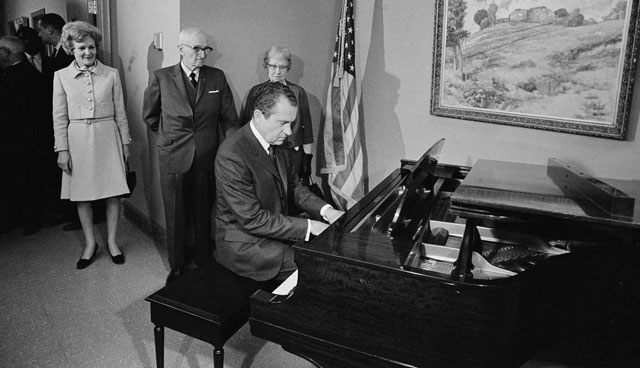
COMMENT | CHRIS PATTEN | In Seize the Hour, her excellent book about the first meeting between US President Richard Nixon and Communist Party of China Chairman Mao Zedong in Beijing, the historian Margaret MacMillan enumerated some of the profound implications of this extraordinary encounter.
The meeting, which took place 50 years ago this month, ended a long political standoff between the United States and communist China, and marked the beginning of a new geopolitical era. And it indicated, perhaps, that there could be no permanent peace in the world unless China and America were able to work together.
But what should be the basis for the Sino-American relationship? For Nixon and his national security adviser, Henry Kissinger, the meeting was to undermine the Soviet Union’s global influence by driving a wedge between the world’s two most important communist countries. Nixon’s visit also enhanced his reputation as a global statesman, whatever his domestic reputation in the US. As Chinese Premier Zhou Enlai observed, “a farsighted man” who knew how to steer the helm of the ship of state through stormy waters had fundamentally changed the way that China and America dealt with each other.
There were also short-term consequences, of course. Nixon’s visit may have encouraged North Vietnam to be more responsive to America’s efforts to end the Vietnam War. The Soviet Union certainly was very concerned about the historic US-China rapprochement, and some of America’s Asian allies – Japan and Taiwan, for example – worried that the US might push them to one side.
But, in retrospect, arguably the most important legacy of the Nixon-Mao meeting is that it made possible some of the other major developments that followed. Nixon’s fall in 1974 came two years before the deaths of both Mao and Zhou. Following Mao’s death, his chosen successor, Hua Guofeng, aided by the armed forces, swiftly ousted the so-called Gang of Four, Mao’s main radical allies during the Cultural Revolution. This cleared the way for the eventual return to power of Deng Xiaoping, which triggered the beginning of China’s economic opening to the world. This would never have happened had China remained cut off from America and the rest of the world.
China’s economic rise in the subsequent decades, driven largely by exports to open world markets, has been phenomenal, transforming the country and its prospects. The economic and trade environment that enabled the Chinese miracle was created largely by the international policies of the rich world’s democracies. In one 15-year period covering the 1990s, for example, China’s exports to the US increased by 1,600%.
But while the world’s markets have been largely open to Chinese goods and investment, China has done relatively little to reciprocate. It has stolen intellectual property from America and Europe, and demanded that other countries kowtow politically in exchange for frequently illusory trade benefits. China persuaded other countries to admit it to the World Trade Organization in 2001, but has since regularly bent and circumvented WTO rules.
Under President Xi Jinping, China has emerged as a more brazen bully. Xi’s China has broken its promises on economic, security, and political issues, handcuffed Hong Kong, militarized islands and atolls in the South China Sea, threatened Taiwan, and been accused of pursuing genocidal policies against Muslim Uyghurs in Xinjiang. It is regarded across the US political spectrum as an increasingly dangerous surveillance state that poses a threat to open societies everywhere, and to efforts to create a balanced global order.
The challenge for the US and other democracies is to manage the relationship with a menacing communist China while involving it – as we must – in efforts to address issues affecting the future of the planet, above all climate change. Xi’s regime does not accept that it should act in accordance with international agreements, and it rejects the views of open societies on what constitutes acceptable governance. But while we need to constrain China, and deter it from behaving badly, we must avoid isolating it.
If Nixon was on the world stage today, I hope he would remind us that China’s communist regime fears the strength of democratic societies as an existential threat. After all, open societies have a free press, accountable government answerable to informed citizens, and an education system that encourages critical thinking rather than indoctrination. When democracies understand and live by their principal governing values, they have nothing to fear in standing up to China.
Fifty years after Nixon’s historic visit to China, those values remain a better long-term bet than totalitarianism. Democracies should not be dazzled by China’s undoubted technological advances; it is the most populous country in the world and has many able citizens. The surprise, rather, is that it hasn’t done even better. In any case, we must hope that Chinese successes will benefit all of humanity, just as open societies’ advances have benefited China.
But what China in the modern era has never succeeded in doing is finding an acceptable long-term governance model. Standing up for the values of open societies may be the best way to help the country – and ourselves.
*****
 Chris Patten, the last British governor of Hong Kong and a former EU commissioner for external affairs, is Chancellor of the University of Oxford.
Chris Patten, the last British governor of Hong Kong and a former EU commissioner for external affairs, is Chancellor of the University of Oxford.
Copyright: Project Syndicate, 2022
 The Independent Uganda: You get the Truth we Pay the Price
The Independent Uganda: You get the Truth we Pay the Price



